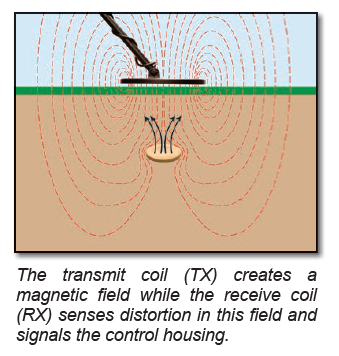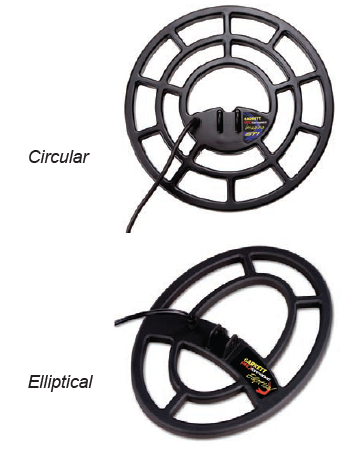The searchcoil is a vital part of your metal detector. It generates a magnetic field and senses metallic targets in the surrounding environment. The size and depth of the magnetic field is determined by the shape and size of the searchcoil. Understanding the purposes behind the various sizes and shapes of searchcoils will empower you with the ability to choose the best coil for each application.
HOW SEARCHCOILS WORK
Searchcoils generally consist of two internal sets of coiled wires, a Transmit Coil (TX) and a Receive Coil (RX). Mono coils can be different in that one coil acts as both the TX and the RX. When the detector is turned on, the TX coil generates a magnetic field in the surrounding space. When a metallic object is within this generated magnetic field, it will create a distortion in the magnetic field. The RX coil will sense this distortion and send a signal to the control housing. A searchcoil’s detection pattern is determined by the combination of the TX’s generated field pattern and the RX’s sensing field pattern.
SEARCHCOIL DEPTH
The detection depth of a searchcoil, as a rule-of-thumb, will be approximately equal to its diameter, for a coin-sized object. However, as a searchcoil’s size increases and its field pattern becomes larger, the field pattern becomes less concentrated and begins to miss small objects. For a coin-sized object, this effect becomes noticeable when using searchcoils larger than about 15" in diameter. Since the field generated by a large searchcoil is larger, deeper and less concentrated than a small searchcoil, it is the best choice when hunting for targets that are usually large and deeply buried, such as caches or relics. there is a direct relationship between the size of a magnetic fi eld and the size of a coil. The bigger the coil, the larger the magnetic fi eld. Therefore, larger searchcoils generally detect deeper than smaller searchcoils.
SEARCHCOIL SIZES
- Smaller Search Coils (less than 6" in diameter): Great for “trashy” areas, really allowing you to sift through metal debris. These coils are best for tighter places and the smallest, shallow targets. Because the magnetic field of a small search coil is concentrated within a small volume, it is the best choice for hunting in areas with a lot of metal debris. This allows you to maneuver through and around trash to locate good targets, especially when searching in tight places where large searchcoils cannot go. In addition, because of their concentrated detection field, small searchcoils are the best for detecting very small objects. However, a small searchcoil provides less coverage per sweep; more scans will be required to cover a search area.
- Medium Search Coils (6-11" in diameter): Usually come standard with your metal detector, medium search coils are designed for general use in finding the broadest range of targets in the broadest range of environments. For general-purpose hunting, which typically includes coins and coin-sized targets, a medium sized searchcoil (8 - 9") is the best choice. Because a medium sized searchcoil provides the best combination of magnetic field concentration, detection depth and capability to detect the greatest range of target sizes within the detection area, it is standard with most detectors. In addition, it’s lightweight and easy to maneuver.
- Large Search Coils (over 11" in diameter): The larger the search coil, the deeper it will penetrate the ground. Great for finding caches or relic hunting, finding deeply buried, large targets. Large searchcoils generate wider and deeper magnetic fields than small coils and consequently provide greater depth and coverage. This means that scanning a search area requires fewer sweeps with a large searchcoil than with a smaller coil. This larger scan area, however, can become a problem in trashy areas where the search coil is detecting several targets at once.

SEARCHCOIL SHAPES
Generally, search coils are circular or elliptical in shape. An elliptical searchcoil is more maneuverable than a circular searchcoil and its narrow width actually provides greater coverage than a circular coil due to its elongated length. However, a circular searchcoil has slightly more detection depth and sensitivity in non-mineralized soil, so it is still the most commonly used shape.
It’s important to understand the pros and cons of using various size, shape and configurations of coils because simply changing the search coil on your metal detector is the next best thing to buying a whole new machine! Most metal detectors come with a standard search coil that is good for general use – finding the broadest range of targets in the broadest range of environments. But search coils come in all shapes and sizes, and it's possible that merely changing the coil on your detector will lead you to a host of new targets in that “hunted out” area.
Garrett is the global leader of ground search metal detectors, pinpointers, coils, and other accessories. Browse Garrett detectors and more.
Part 2 — search coil configurations







